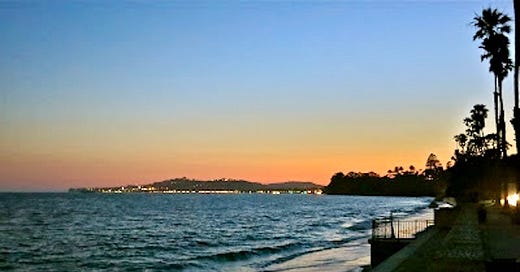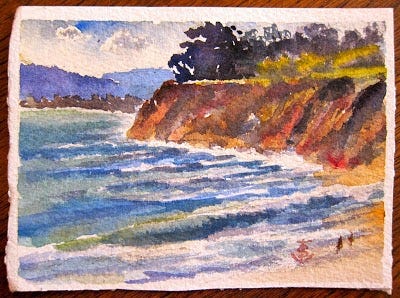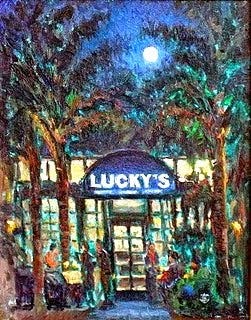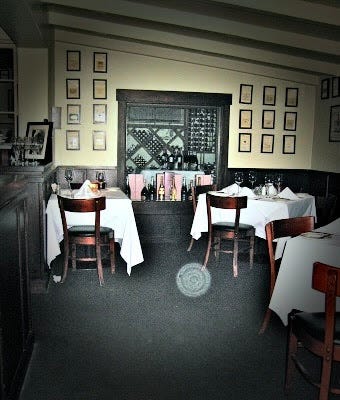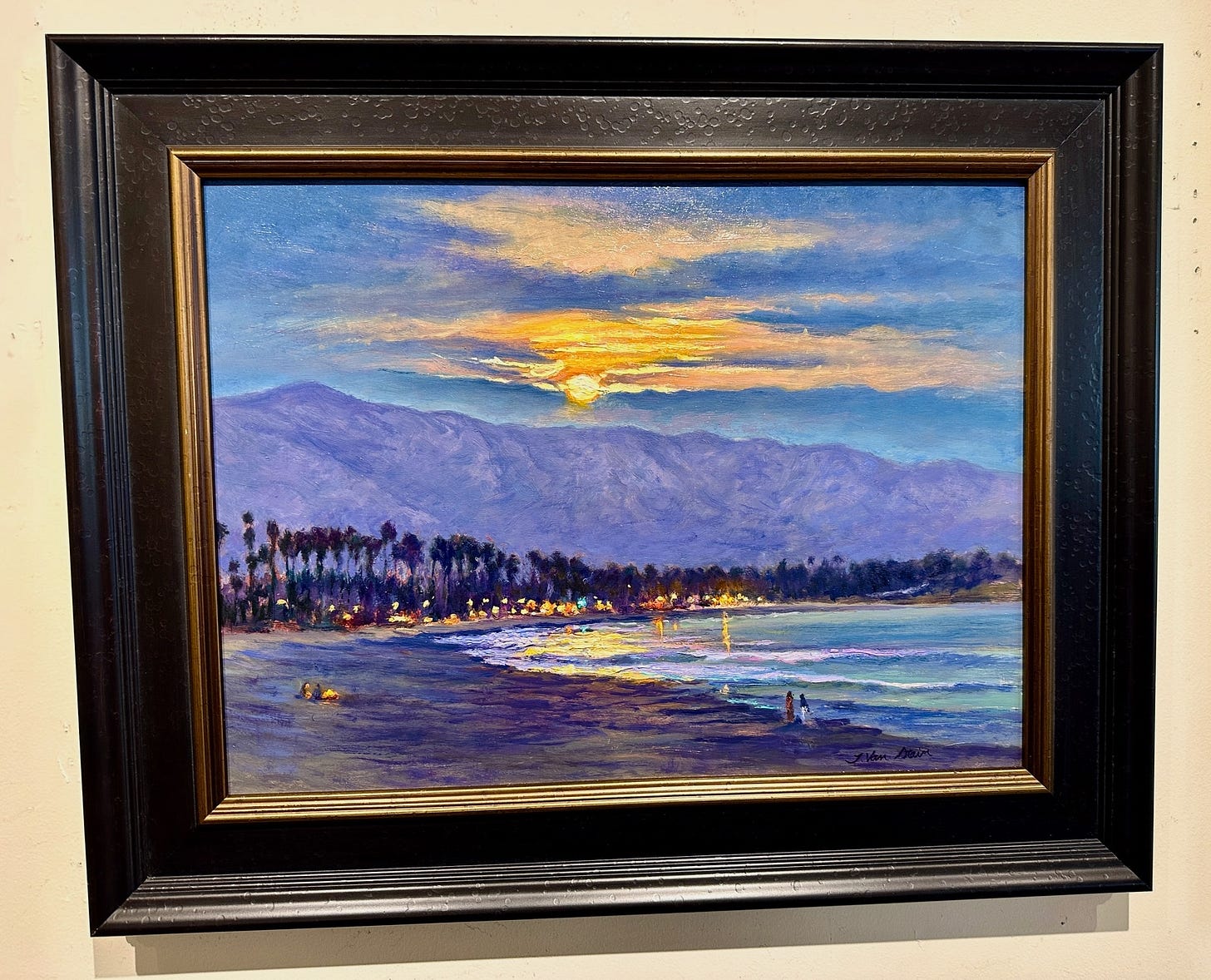June 2001
By day, Butterfly Beach
By night, Lucky’s
Emergencies only: (my cell phone number)
This is the calling card I conjure up (if only in my mind) to reflect my incognito-ness, though I’ve always eschewed resumes and business cards—anything, in fact, that leads a trail to wherever I am.
For wheels, a Jeep Liberty sets the mood. And with Independence Day looming, my presence in Montecito feels like it was deigned by heaven, which, in this village, is pitch black, cloudless and decorated by a multitude of stars almost every night.
My new office—Starbucks—is everyone’s office, including Dennis Miller, Rob Lowe, and Peter Noone a.k.a. Herman of the Hermits.
It is also headquarters for the coffee-mom contingent, though these aren’t moms you’ll see in Indiana or New Jersey. These are blonde ex-models who made a bundle shooting the swimsuit issue for Sport’s Illustrated. Or they were aspiring models until they married a bag of bones, more than once.
Aside from all the expensive nips and tucks (men, too), you still cannot tell these are mostly multi-millionaires, because the moment someone abandons a News-Press, three or more Montecitans pounce on it, not wanting to part with four bits for their own newspaper.
The worst culprit, a displaced Brit named Michael Murphy, is partly responsible for my move here because of some unsolicited if sage advice he conveyed at Montecito Bar as I conducted pre-move reconnaissance over Grey Goose, up, three olives: “You’re only here a short time—you might as well live someplace nice.”
Murphy is not content with grabbing just one newspaper. He scours Starbucks collecting as many as he can find, for reasons only a shrink might understand.
Make no mistake: There is no place finer place to live than mellow Montecito.
Talk about mellow: After a few days, your wristwatch slows down.
Talk about mellow: You cannot order a glass of water without whipped cream.
Talk about mellow: The tree in my garden sprouts cotton candy.
Donna Karan lunches in the open-air at Tutti’s while I pump gas next to Jeff Bridges pumping his own at the corner 76 station (gone now), which, on a quiet Sunday morning, could have been painted by Edward Hopper.
I round into Mailboxes Etc to collect my mail—and almost collide with Christopher Lloyd, the mad professor from Back to the Future, inducing him into the kind of startled, bug-eyed body-freeze people pay good money to see at the movies. I now realize this is not method acting but a reaction that comes natural to him.
When I see God, i.e., Jonathan Winters, fondling cantaloupe in the produce department at Von’s, I want to break the unwritten Montecito code about approaching celebrities—don’t—but I restrain myself. For now.
Many American and British comedians somehow found Montecito and settled-into life behind the hedges where they can hide out from those whose ribs they tickle.
John Cleese is said (by himself) to have embarked on a road-trip from LA to scout a second home somewhere along the Pacific Northwest, but traveled no further than mellow Montecito. (He’s gone now, like the old ‘76 station.)
Steve Martin lives in a concrete bunker with his valuable art collection, appearing at Pierre Lafond (a market in the upper village) at precisely 8:42 every Sunday morning for take-out coffee, the visor of his baseball cap tilted downward over dark glasses to avoid eye contact, an anal antithesis of approachability.
Hollywood North. Behind the Hedge. Asylum Without Walls.
Three of Montecito’s monikers.
Movie and television actors lurk everywhere, though most residents are first generation rock ‘n’ roll songwriters with 40-plus years’ royalties behind them. And TV sit-com writers who won the lottery when their baby hit a hundred and went into syndication after ruining yet another generation.
The latter are constantly hoping to be recognized by someone, anyone, preferably a movie or TV celebrity.
This results in the Montecito Look: Whenever you walk into a bar or restaurant, whether it’s Tom’s Coffee Shop (Robert Mitchum‘s final hangout, adjacent to San Ysidro Pharmacy) or Lucky’s Bar and Grill, the natives look up to see who you are—or aren’t.
Like most places, the natives can tell whether or not you belong by how you’re dressed.
The Montecito male attires himself in a Hawaiian shirt hanging over blue jeans (only dweebs tuck them in). Never, ever wear shorts at night, no matter how warm it is. The appropriate footwear is Merrell slip-ons.
If you’re wearing a crew-neck black tee, you are obviously from LA, so you’re the least welcome of all because you still have something to prove (loudly, often profanely, over your cell phone, non-stop), because you’re still waiting to score high enough in Hollywood to buy a second home in Montecito or move in full-time—and you’re probably over-caffeinated and honking your horn (whether you’re driving a car or not).
Black apparel is for big cities. In these bucolic parts, brown is the correct color for adorning oneself. As for designer accessories: Not only are they unnecessary, but downright loathsome.
The first section I consult in the daily News-Press is not news, but the tide report. This is for scheduling long walks at low tide along Butterfly Beach (sunsets and moonrises, also noted), a stretch of fine sand and gentle rolling waves framed with pure white flotsam.
Dolphins swim past, waving their flippers; a fat seal lounges on his favorite boulder when the tide pulls out.
I call it The Club. It is healthier, more fitness oriented and more socially stimulating than fancy-pants country clubs that charge a hefty membership fee and monthly dues then tell you what to wear and how to behave.
When you pass another native walking the beach, there’s an acknowledgement—a wink, a nod—that you are privy to a magical secret with these unspoken words: Too blessed to be stressed.
Montecito sits on a coastline facing south over the ocean (not west, like the rest of California) and, consequently, enjoys a microclimate unique to itself. The Santa Ynez Mountains behind the city and the uninhabited Channel Islands (a nature preserve 20 miles away) ensure that the American Riviera never heats much beyond 75 degrees Fahrenheit nor cools below the low 40s at night, year-round.
You need air conditioning? Open a window.
Butterfly Beach abounds with pleasant views of the islands, the mountains, pretty young women in bikinis—and local characters, including:
The Dancing Beach Lady. A middle-aged woman who fox-trots her way down the beach, fingers snapping, buttocks twisting, dachshund in tow, oblivious to the amusement and befuddlement she stirs amongst those she leaves in her wake. She is possibly a victim of the SB Itch, a beach flea that plagues the local canine community. Or otherwise a simple case of someone who follows their own beat.
The Garbalogist. A scruffy, sinewy, very strange man with few teeth on a bicycle who scrounges canisters of refuse on stairway approaches to the beach. He meticulously sorts the contents for whatever pieces fit the grand puzzle he is doubtless assembling at his laboratory somewhere. The Garbalogist does not smile, never speaks and cannot be tempted into conversation. If you offer a “good morning,” his glare suggests paranoid schizophrenia.
The Searcher. A short, squat, lecherous-looking old guy with a full head of wiry grey hair tied into a ponytail, a barrel-shaped torso and swim trunks that list precariously beneath a large paunch, exposing an unsightly plumber’s crack at posterior end. His mouth is perpetually open, as if gravity is pulling not only at his swim trunks but also his chin; he cups a hand over his eyes, shielding them from the sun, gazing out to sea as if he’s searching for his ship, yet to come in. He does this all afternoon. And the next. And the next.
Dina and Her Pet Guy. This pampered Pekinese has trained her guy, never without floppy sun hat and rose-tinted glasses, to carry her around the Channel Drive/Coast Village Road circuit.
The Thin Man. This guy walks the beach every morning—always alone, a haunted look on his narrow, gaunt face. You can pass within inches of him, nod or say hello, and he sees right through you, lost in grief, or burned out by teenage excess.
The Montecito ‘tude: Done what I wanted to do (and earned dough doing it), now I’m gonna have some fun!
Or, as a local realtor puts it, “People around here do what they want. If they get caught, they ask for forgiveness, it’s easier than permission.”
Entry fee to this climate-controlled coastal paradise: Over two mil for a two-bed, two bath cottage (Oprah Winfrey paid $51 million for her estate), though you can rent reasonably if you don’t mind railroad tracks, like, right next to them, sandwiched between the tracks and Interstate 101.
The good news: After a few nights your brain develops an immunity to the 4:42 a.m. Amtrak that screeches by, horn a-blare, as if it’s coming through your window.
Around five o’clock when the sun begins to set, a watering hole on the east end of Coast Village Road hosts the natives. The walls of Lucky’s are adorned with black-and-white photographs of dead thespians and crooners in homage to Hollywood as it once was. Servers are dressed formally but management does not expect the same of its laid-back patrons, the likes of whom include folk-rocker David Crosby (gone now, forever, God bless him) who grew up in Montecito and drives in from Santa Ynez for beef stroganoff; the carrot-topped novelist T.C. Boyle, in trademark red Converse sneakers; Kirk Douglas (also gone), Carol Burnett, Bo Derek, and Oprah, who craves Chef James Sly’s crispy thin fries and salty turtle sundaes.
Beer comes in a frosted mug; generously-poured dry martinis are stirred to perfection by Matt (gone) and Ezra. The menu, classic American fare, features Andy’s Baby Back Ribs, after Formula One driver Andy Granatelli (gone), who owns a corner table.
Charlie Chaplin’s ghost is present when he gets bored with the Montecito Inn adjacent. Local lore has it that Charlie created the inn 1928 as a weekend getaway for himself and friends.
Now Charlie pulls playful pranks on patrons.
For instance, he’ll jerk a barstool, prompting a male customer to pratfall while concurrently causing a female to slip on an imaginary banana skin, and they’ll engage each other on the floor—Charlie’s slapstick style of sparking seduction.
Strangely, no injuries occur from these pratfalls and slippages (which, of course, have nothing to do with martinis.)
Charlie, costumed as The Tramp, is seen walking through walls in Lucky’s Bamboo Room; he flicks empty glasses off serving trays, taps the shoulders of patrons and, when washrooms are occupied, switches the lights off or jiggles sliding locks to show “vacant,” resulting in mirthful (if mortifying) encounters.
Lucky’s Table 80 belongs to Charlie. That’s the one whose candle mysteriously alights at evening’s end when all other candles, and lights, are extinguished.
It’s all good theater, starring household names, with sides of creamed corn and rapini.
The latest collection of paintings by Thomas Van Stein are now on show at…

